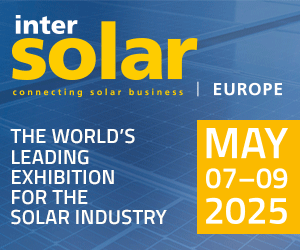Despite sinking oil prices, worldwide demand for power generated from photovoltaics (PV) is rising. Around the globe, plummeting system prices are promoting the construction of PV power plants. At the same time, business models in the industry are changing due to cuts in state funding, calling for new financing and profit models and positioning solar energy as a promising investment opportunity. The international solar industry is meeting at Intersolar Europe in Munich from June 10–12, 2015 to find out about current market developments, new technologies and potential applications.
Photovoltaic installations are playing an increasingly important role in power generation worldwide. According to marketing research company IHS, 2015 will see demand grow by 16% to 25% and an additional 53 to 57 gigawatts (GW) installed. While steady growth is on the cards for Europe, it is markets like China, Japan and the USA that are driving the industry forward.
Grid parity in four out of five countries as early as 2018
According to calculations from Deutsche Bank, demand for solar power will continue to grow despite reductions in oil prices. The analysis sees solar energy become increasingly profitable to generate, with solar module costs dropping by 40% in the next four to five years. The bank’s 2015 Solar Outlook also predicts that grid parity could be achieved in up to 80% of the world’s markets as early as three years from now.
In many countries, grid parity has already been achieved by domestic and commercial PV installations alike, which produce solar power at costs up to 60% less than the rates charged by energy providers. According to calculations from the German Association of Energy and Water Industries, private consumers in Germany, for example, pay an average of 29.13 euro cents per kWh compared with the 10–15 euro cents it would cost to generate solar power from their own roofs. This increases the attractiveness of on-site consumption and provides additional impetus for the growing storage system market.
New avenues for solar investments
A further development is also taking place, and is set to change the market in many countries – states are providing less and less funding for photovoltaics. In Europe, feed-in tariffs are on their way out. The German government, for example, is progressively reducing funding in accordance with the Renewable Energy Sources Act, with the aim of fading it out completely after expansion goals have been met. In response, the industry has developed new, increasingly relevant business and financing models. Measures now range from rental and leasing models and direct marketing of solar power to listed operating companies (known as a yield co) and shares in green bonds.
According to certification and consulting company DNV GL, leasing models are now particularly widespread in the USA. These models see investors finance the construction of photovoltaic installations on small houses. The investors retain ownership of the systems, while home owners pay fixed rates to use the energy generated. Meanwhile, shares in operating companies and green bonds are becoming increasingly interesting for institutional investors, with DNV GL reporting green bond investments of 14 billion US dollars in 2013 alone. Bonds may either be issued for specific projects, such as large-scale PV power plants, or for more general investments in environmentally friendly infrastructure.
Intersolar Europe: Financing and markets under the spotlight
For the financial industry, the new models offer the chance to invest in a future-proof technology that has undergone many years of testing and will continue to be developed as a pillar of energy supply. Boasting an installed capacity of around 90 GW, Europe holds the world’s largest market share. Years of experience gained in operating, maintaining and managing PV power plants guarantee high investment security today. From June 10–12, around 1,000 exhibitors will gather at this year’s Intersolar Europe, the information and strategy program for the solar industry, to showcase their technical expertise and new application solutions.
New financing and profit models are one of the focal points of the accompanying Intersolar Europe Conference, which will take place in the ICM – Internationales Congress Center München from June 9–10. Here, a variety of issues will be discussed, such as how local energy providers can work with project developers and financial institutes to realize future photovoltaic projects. The conference also provides detailed insights into individual markets, with a focus on new regulations in European states as well as the opportunities opened up by an increase in electricity consumption in Asian countries.








